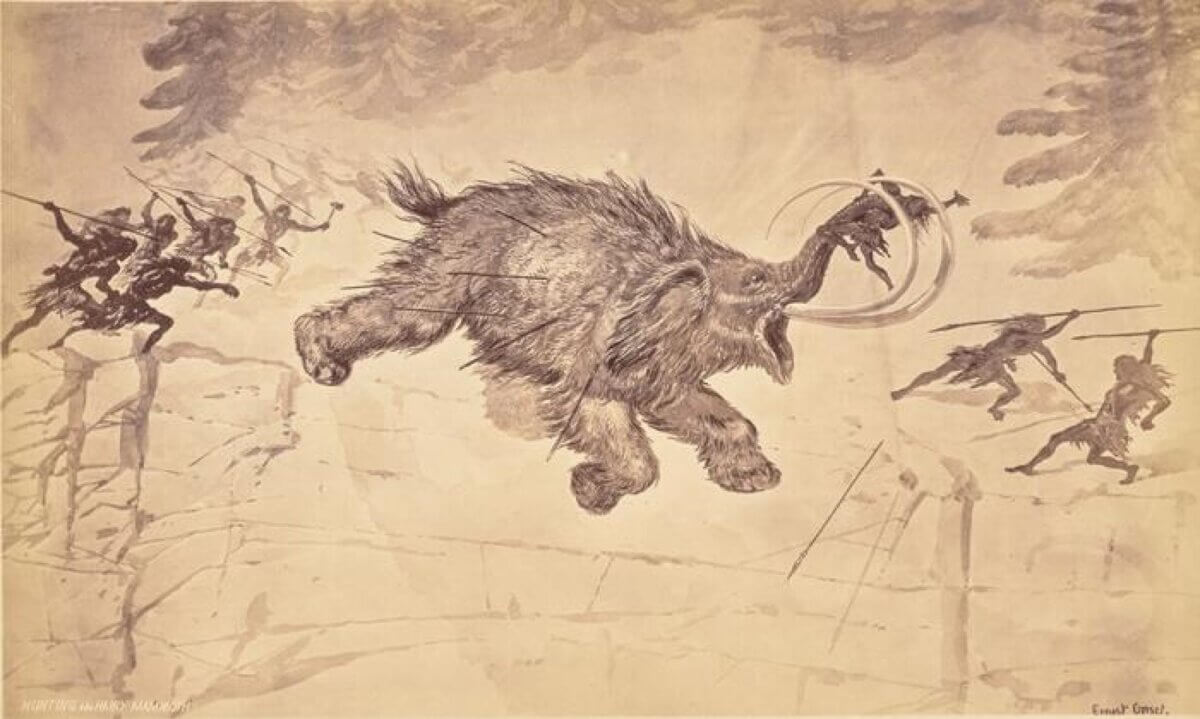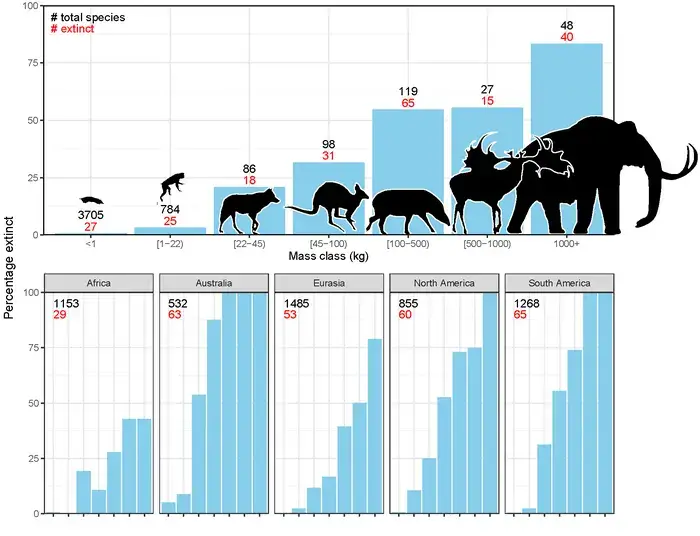
Prehistoric humans hunted the woolly mammoth. A growing body of research shows that this species—and at least 46 other megaherbivore species—was driven to extinction by humans. (CREDIT: Engraving by Ernest Grise, photographed by William Henry Jackson. Courtesy of Getty’s Open Content Program)
AARHUS, Denmark — Imagine a world where elephants roamed Europe, giant ground sloths roamed the Americas, and car-sized armadillos burrowed in the grasslands of South America. This wasn’t some fantasy world out of a Hollywood movie, but Earth 50,000 years ago. But something happened. These megafauna, animals weighing more than 110 pounds, began to disappear. By 10,000 years ago, most of them were gone forever.
What caused this mass extinction that reshaped life on our planet? It’s a question that has puzzled scientists for more than 200 years. Now, an international team of researchers has conducted a comprehensive analysis of the evidence and concluded that prehistoric humans were likely the main culprits in the downfall of Earth’s giants.
The study, led by scientists from the Danish National Research Foundation’s Centre for Ecological Dynamics in a New Biosphere (ECONOVO) at Aarhus University, analyzed patterns of megafauna extinction across multiple continents and time periods. They found that large animals began to disappear shortly after humans arrived in new regions, with extinction rates highest where humans were most novel.
“The massive and selective extinction of megafauna over the past 50,000 years is unique in the past 66 million years. Previous periods of climate change have not led to massive and selective extinctions, arguing against a major role for climate in megafauna extinctions,” said Professor Jens-Christian Svenning, lead author of the study, in a statement.
The researchers point out that climate change, long considered a potential cause of the extinctions, does not adequately explain the observed trends. While the end of the Pleistocene did see significant climate changes, they were no more extreme than previous glacial cycles that did not cause mass extinctions.
“Another significant pattern that argues against the role of climate is that recent megafauna extinctions have hit climatically stable areas as hard as unstable areas,” Svenning adds.
Furthermore, megafauna losses were highly selective, affecting mainly the largest species. Smaller animals, plants, and marine life were largely unaffected. This size bias is consistent with what one would expect from human hunting pressure, not climate change.
The study found that at least 161 species of mammals went extinct during that time, based on the remains found so far. The largest animals were hit hardest: terrestrial herbivores weighing more than a ton, called megaherbivores. Fifty thousand years ago, there were 57 species of megaherbivores. Today, there are only 11 left, and even those surviving species have seen drastic population declines.


Interestingly, regions where humans have a longer evolutionary history with large animals have experienced fewer severe extinctions. In Africa and parts of Asia, where hominids had been present for millions of years, fewer megafauna species have gone extinct than in the Americas and Australia. This suggests that animals in Africa and Asia may have evolved behaviors to avoid human predators over time. Researchers have found evidence of human hunting prowess in the archaeological record.
“Early modern humans were effective hunters, even of the largest animal species, and clearly had the ability to reduce populations of large animals,” Svenning notes. “These large animals were and are particularly vulnerable to overexploitation because they have long gestation periods, produce very few offspring at a time, and take many years to reach sexual maturity.”
The loss of these ecosystem giants had profound consequences that continue to shape our world today. Large herbivores like mammoths and ground sloths played a crucial role in maintaining open habitats and dispersing nutrients across landscapes. Their loss likely contributed to the spread of forests and changes in fire regimes in many regions.
“Species have disappeared on every continent except Antarctica, and in every type of ecosystem, from tropical forests and savannas to Mediterranean and temperate forests and steppes to Arctic ecosystems. Many of the species that have disappeared could have thrived in different types of environments. Their extinction therefore cannot be explained by climate change causing the disappearance of a specific type of ecosystem, such as the mammoth steppe, which also supported only a few species of megafauna,” Svenning points out.
The authors argue that understanding this extinction event is crucial as we face a biodiversity crisis today. By recognizing the historical impact of humans on animal populations, we can better inform conservation efforts. They even suggest the “reintroduction” of large animals to restore lost ecological functions as a potential conservation strategy.
“Our results highlight the need for active conservation and restoration efforts. By reintroducing large mammals, we can help restore ecological balances and support biodiversity, which has evolved in ecosystems rich in megafauna,” concludes Svenning.
The study is published in the journal Cambridge Prisms: Extinction.
Methodology
The researchers conducted a broad literature review, examining data from paleontology, archaeology, genetics, and ecology. They analyzed patterns of megafauna extinctions across continents, at different times, and across body sizes. The team also evaluated various hypotheses about extinctions, including climate change and human impacts, against the observed patterns. Their study spanned several areas of research, including studies of the timing of species extinctions, animal dietary preferences, climate and habitat requirements, genetic estimates of past population sizes, and evidence of human hunting.
Results
The study found that megafauna extinctions were global in scale but varied in intensity across regions. They were heavily biased toward larger species and temporally linked to the arrival of humans in new areas. The extinctions were not solely driven by climate change. The researchers found that at least 161 mammal species disappeared during this period, with terrestrial herbivores weighing more than a ton (megaherbivores) being the most severely affected.
Boundaries
Possible limitations of this study include that fossils are incomplete, especially for small species, which can bias our understanding of extinction patterns. Dating of extinction events and human arrivals can be imprecise, making it difficult to establish accurate temporal relationships. Additionally, the complex interactions between humans, climate, and ecosystems are difficult to fully untangle, especially over such long time scales.
Discussion and takeaways
The researchers conclude that hunting and human modification of ecosystems were likely the primary drivers of the late Quaternary megafauna extinctions. They argue that this event constitutes an early example of human-induced environmental change on a global scale. The study highlights that humans have been shaping ecosystems for tens of thousands of years, and that large animals are particularly vulnerable to human impacts. The loss of megafauna has had cascading effects on landscapes and ecosystems, altering vegetation structures, seed dispersal patterns, and nutrient cycling. The authors emphasize the importance of understanding past extinctions to inform modern conservation efforts. They suggest that rewilding with large animals could help restore lost ecological functions and support biodiversity in ecosystems that evolved with megafauna.